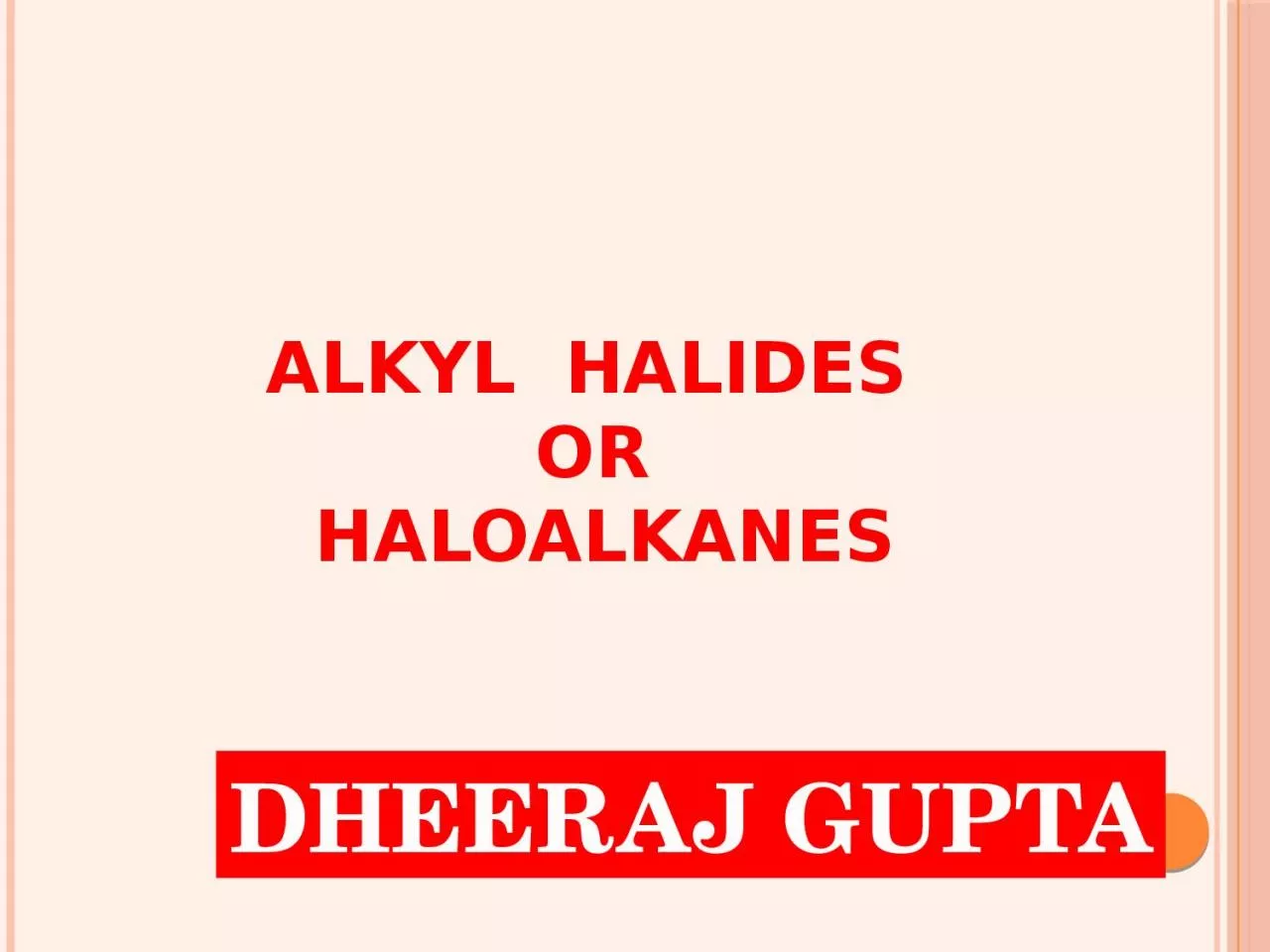

HALOALKANES DHEERAJ GUPTA ALKYL HALIDES OR HALOALKANES An organic compound containing at least one carbonhalogen bond CX X F Cl Br I replaces H Alkyl halides are organic molecules containing a halogen atom bonded to an ID: 1001494
Download Presentation The PPT/PDF document "ALKYL HALIDES OR" is the property of its rightful owner. Permission is granted to download and print the materials on this web site for personal, non-commercial use only, and to display it on your personal computer provided you do not modify the materials and that you retain all copyright notices contained in the materials. By downloading content from our website, you accept the terms of this agreement.
1. ALKYL HALIDES OR HALOALKANESDHEERAJ GUPTA
2. ALKYL HALIDES OR HALOALKANESAn organic compound containing at least one carbon-halogen bond (C-X)X (F, Cl, Br, I) replaces HAlkyl halides are organic molecules containing a halogen atom bonded to an sp3 hybridized carbon atom. Can contain many C-X bondsProperties and some usesFire-resistant solventsRefrigerantsPharmaceuticals and precursors
3. Nomenclature Alkyl HalidesSelect the longest chain of carbon that contains the halogen atom.Give least possible number to the halogen atom.The carbon containing double or triple bond is given the least number.Place the suitable suffix like di, tri, tetra for 2, 3, 4 halogen atoms respectively.Name the compounds as halo alkanes, halo alkenes or halo alkynes.For example,
4. Structure of Alkyl HalidesC-X bond is longer as you go down periodic tableC-X bond is weaker as you go down periodic tableC-X bond is polarized with partial positive charge on carbon and partial negative charge on halogen
5. CLASSIFICATION OF ALKYL HALIDESAlkyl halides are classified as primary (1°), secondary (2°), or tertiary (3°), depending on the number of carbons bonded to the carbon with the halogen atom.The halogen atom in halides is often denoted by the symbol “X”.
6. On the basis of number of halogen atoms present, halogen derivatives are classified as mono,di, tri, tetra, etc., halogen derivatives, e.g.,
7. Vinyl halides have a halogen atom (X) bonded to a C—C double bond.Aryl halides have a halogen atom bonded to a benzene ring.Allylic halides have X bonded to the carbon atom adjacent to a C—C double bond.Benzylic halides have X bonded to the carbon atom adjacent to a benzene ring.
8. General Methods of Preparation of Haloalkanes1. From AlcoholsIn Groove’s method, ZnC12 is used to weaken the C-OH bond. In case of 3° alcohols, ZnC12 is not required.The reactivity order of halogen acids is HI > HBr > HCl.Darzen procedure is the best method for preparing alkyl halides from alcohols since both the byproducts (SO2 and HCl) are gaseous and escape easily.
9. 2. Free Radical Halogenation of Alkanes3. Addition of Hydrogen Halides on Alkenes
10. 4. Finkelstein Reaction5.Swarts ReactionH3C – Br + AgF → H3C – F + AgBrHg2F2, COF2 and SbF3 can also be used as a reagent for Swarts reaction.6. Hunsdiecker Reaction
11. Physical Properties of Haloalkanes1. Boiling point orders i) R – I > R – Br > R – CI > R – F ii) CH3 – (CH2)2 – CH2Br > (CH3)2 CHCH2Br > (CH3)3CBr iii) CH3CH2CH2X > CH3CH2X > CH3X2. Bond strength of haloalkanes decreases as the size of the halogen atom increases. Thus, the order of bond strength is CH3F > CH3Cl > CH3Br > CH3I3. Dipole moment decreases as the electronegativity of the halogen decreases.4. Haloalkanes, though polar, but are insoluble in water as they do not form hydrogen bonding with water.5. Density order is RI > RBr > RCl > RF (For the same alkyl group) CH3I > C2H5I > C3H7I
12. Chemical Reactions of Haloalkanes1. Nucleophilic Substitution Reactions (SN reactions)Relative reactivity of alkyl halides for same alkyl group isRI > RBr > RCI > RF
13. KCN is predominantly ionic and provides cyanide ions in solution, which is ambident nucleophile and bind with carbon side to form as the major product, while AgCN is covalent and form isocyanide as the major product.Like KCN, KNO2 form R-ONO while AgNO2 produces R-NO2 as product. Vinyl chloride is less reactive towards nucleophilic substitution reactions due to resonance.
14. Nucleophilic substitution reactions are of two typesSN1 type :- Unimolecular nucleophilic substitution reactions proceed in two stepsRate, r = k [RX]. It is a first order reaction.Reactivity order of alkyl halide towards SN1 mechanism 3° > 2° > 1°Polar solvents, low concentration of nucleophiles and weak nucleophiles favour SN1 mechanism
15. In SN1 reactions, partial racemisation occurs due to the possibility of frontal as well as backside attack on planar carbocation.
16.
17. (b) SN2 type:-(Bimolecular nucleophilic substitution) These reactions proceed in one step and is a second order reaction with r = k[RX] [Nu]. During SN2 reaction, inversion of configuration occurs (Walden inversion) i.e., starting with dextrorotatory halide a laevo product is obtained and vice-versa,Reactivity of halides towards SN2 mechanism is 1° > 2° > 3°Rate of reaction in SN2 mechanism depends on the strength of the attacking nucleophile.Strength of some common nucleophiles is:CN- > : I- > : OR- > : OH- > CH3COO: - > H2O > F-Non-polar solvents, strong nucleophiles and high concentration of nucleophiles favour SN2 mechanism
18.
19. Relative rates of some alkyl halides in SN1 and SN2 reactions are in the order
20. 2. Elimination ReactionsDehydrohalogenation is a β – elimination reaction in which halogen is from α-carbon atom and the hydrogen from the α-carbon according to Saytzeff rule, e.g.,Ease of dehydrohalogenation among halides 3° > 2° > 1°
21. 3. Reduction4. Reaction with MetalsGrignard reagent is never isolated in the solid state as it explodes in dry state. So it is used as ethereal solution.
22. 5. lsomerisation
23.
24. Distinction between haloalkanes and haloareneHaloalkane and haloarenes can be distinguished by silver nitrate (AgNO3). Haloalkanes react with AgNO3 to give white precipitate of AgCl while haloarene do not react.RCl + NaOH NaCl + ROH NaCl + AgNO3 AgCl + NaNO3